Yes, People Who Take Omega-3 Supplements for Acne or Other Purposes Should Not Take More than 2,000 mg per Day

The Essential Info
Three studies have shown that omega-3 fatty acids might help reduce acne. That’s only 3 studies, 2 of them very small, and we will need to see them replicated before we know for sure. But it makes sense that omega-3 supplements (fish oil pills) might reduce acne because ingesting omega-3 fatty acids can reduce inflammation, and acne is an inflammatory disease.
But as with most things in life, too much of a good thing can lead to problems. Taking too omega-3 fatty acids in excess can cause side effects including:
- Heartburn
- Nausea
- Stomach pain
- Diarrhea
- Headaches
- A weakened immune system
- Bleeding in those taking anticoagulant drugs
A good recommendation is to limit your intake of the omega-3 fatty acids called EPA and DHA that are present in fish oil to 2000 mg per day. This can usually be obtained from 6 to 7 pills of fish oil supplements per day, or 3 “concentrated” fish oil supplements. If you are vegetarian, try microalgae (often called algae) supplements.
What I Do: The science behind omega-3s for skin health and overall health feels deep enough to me to commit to supplementing, so I make sure to take 6 cod liver oil pills every day. I use cod liver oil in particular because I don’t get a lot of sun exposure, and cod liver oil also contains vitamin D. I shopped around until I found a brand that didn’t give me fish burps. Fish burps can be a sign that the oil has gone rancid, so find a brand that doesn’t give you fish burps. Tip: I keep mine in the freezer to keep them as fresh as possible.

The Science
- What are Omega-3 Fatty Acids?
- How Much Omega-3 Is Too Much?
- Can Omega-3 Fatty Acids Help Acne?
- Conclusion
What are Omega-3 Fatty Acids?
Omega-3 fatty acids are a group of fat molecules that are abundant in fish and some nuts/seeds.
There is evidence that omega-3 fatty acids reduce inflammation in the body.1,2 Since acne is an inflammatory disease, this has caused some people to wonder if omega-3s might help reduce acne. Research to answer this question is ongoing with some promising initial results.2-4
There are three specific types of omega-3 fatty acids that are important for health:
- Alpha-linolenic acid (ALA) – primarily found in seeds and nuts
- Eicosapentaenoic acid (EPA) – primarily found in wild-caught fish
- Docosahexaenoic acid (DHA) – primarily found in wild-caught fish
All three types of omega-3 fatty acids are “essential” fatty acids, which means we must obtain them directly from the foods in our diets or through supplements, because our bodies cannot produce them on their own.2,5,6
For acne, it’s EPA and DHA that likely matter most: Research has also shown that deficiencies in ALA may be a factor that contributes to acne.5 However, it is EPA and DHA that provide anti-inflammatory benefits, so when it comes to acne, we will concern ourselves mainly with EPA and DHA.
Omega-3 in Food
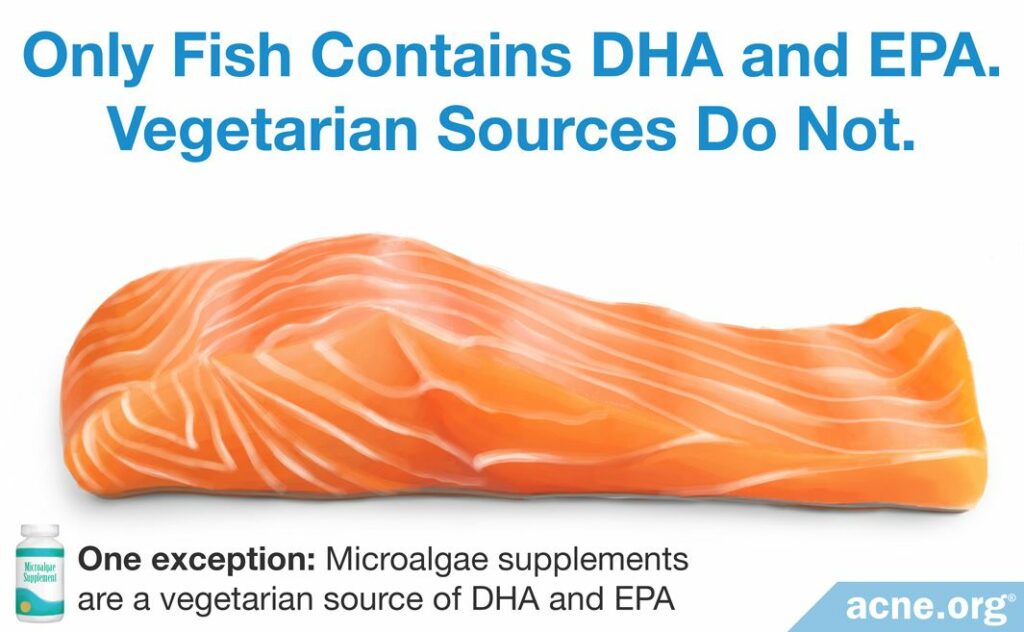
Omega-3s are abundant in various types of foods, and it is unlikely that you will end up ingesting too many omega-3s simply by eating these foods. Some omega-3-rich foods include:
- Wild-caught fish: e.g. salmon, herring, sardines, mackerel, trout (DHA and EPA)
- Seeds and seed oils: e.g. chia seeds, flaxseed oil (ALA)
- Other foods: e.g. canola oil, soybean oil, mayonnaise (ALA)
According to the American Heart Association and the World Health Organization, the best way to get omega-3 fatty acids is by eating 1-2 servings of wild-caught fish per week. Each serving of fish amounts to about 200 to 500 mg of EPA and DHA omega-3s.7 However, this is a general health recommendation. People who wish to take omega-3s for acne may choose to up this dosage by using supplements.
Omega-3 in Supplements
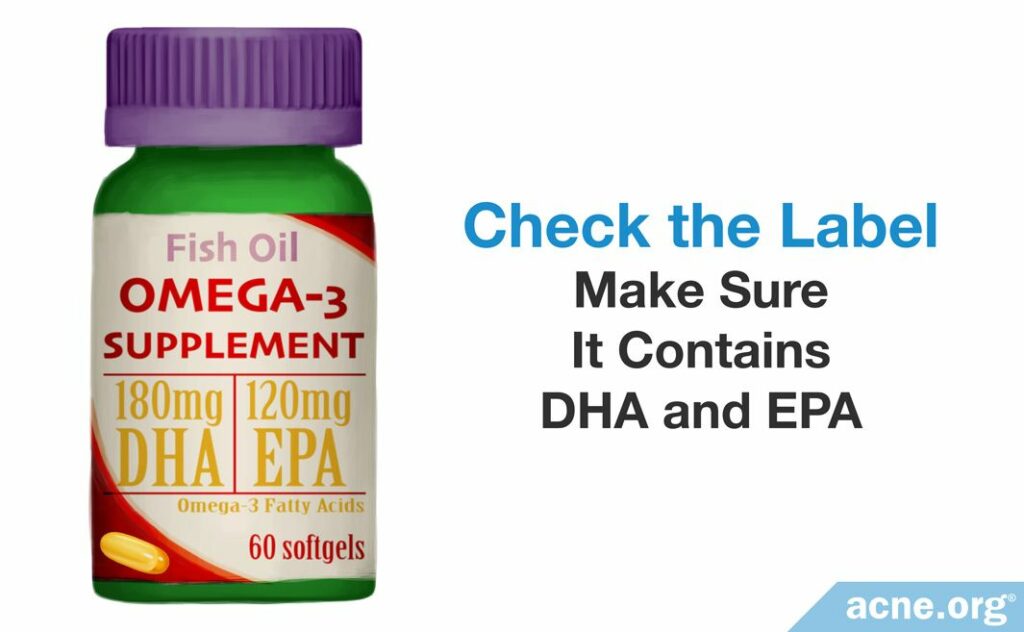
Because it is difficult to eat wild-caught fish on a daily basis, many people use omega-3 fatty acid supplements. It was reported in 2012 that almost 8% of adults in the United States took a fish oil supplement within the previous month.8
What type is best? Omega-3 fatty acid supplements are usually from fish oil, krill oil, or cod liver oil. Any of these is fine. It is the amount of DHA and EPA that is the concern, and not what type of fish it comes from.
Vegetarian supplements: To get DHA and EPA in a vegetarian supplement, microalgae-derived omega-3 supplements are also widely available. It is important to note that other vegetarian omega-3 supplements that come from flaxseed oil, for instance, will only contain ALA, so that’s not your best bet. Whichever supplement you choose, be sure to check the label and make sure it contains DHA and EPA.
How Much Omega-3 Is Too Much?
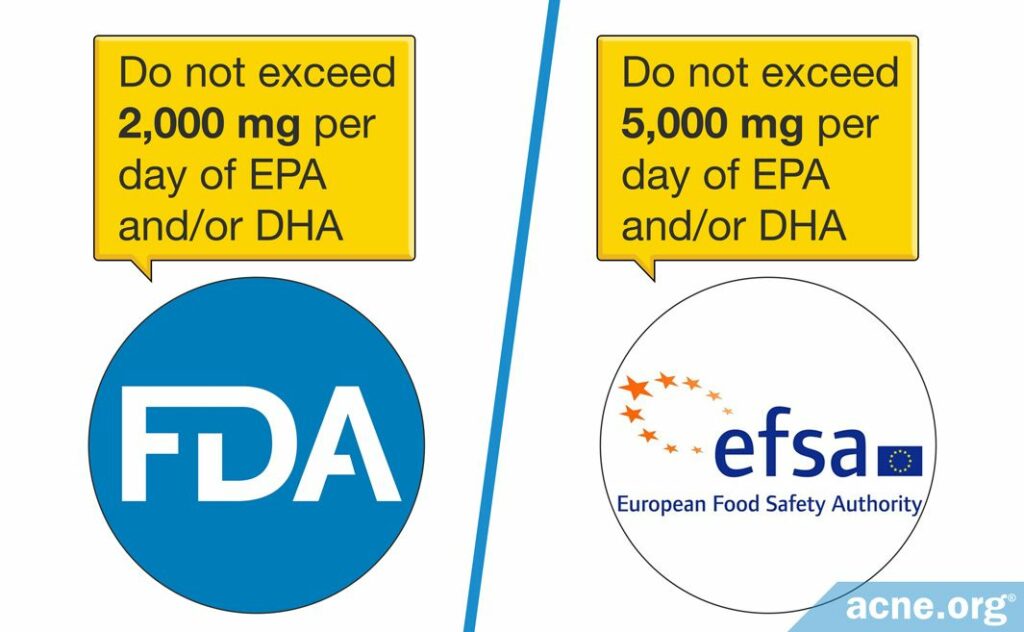
The U.S. Food and Drug Administration (FDA) recommends not exceeding 2,000 mg per day of EPA and DHA from supplements. However, the European Food Safety Authority considers up to 5,000 mg/day of EPA and/or DHA to be safe.6
Since a recent omega-3 study showed a reduction of acne with supplementation of 1,000 mg of EPA plus 1,000 mg DHA omega-3s, and this does not exceed the FDA’s maximum recommendation of 2,000 mg total EPA and DHA per day, this is a good recommended dose for those who choose to take omega-3 fatty acid supplements for acne. This means most people should take:
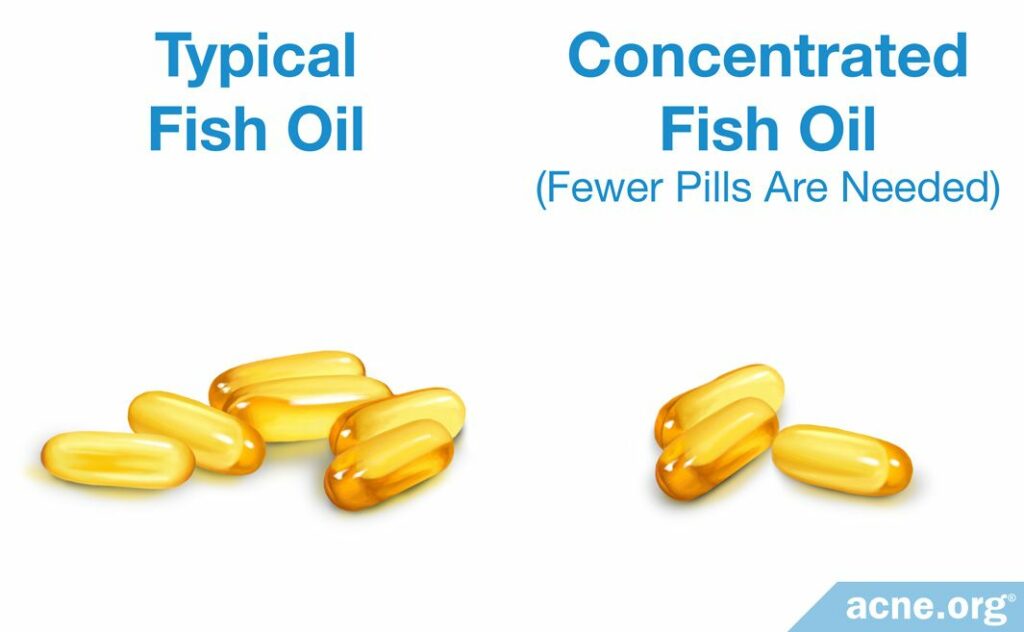
Typical fish oil supplements: Most supplements have 1,000 mg of fish oil per pill, and contain the typical 180 mg of DHA and 120 mg of EPA. In this case a person should take 6 to 7 pills per day in order to get 2,000 mg of EPA and DHA.
Concentrated fish oil supplements: For concentrated supplements that contain more than the typical 180 mg of DHA and 120 mg of EPA, a person will need fewer pills (about 3 or so), depending on how much DHA and EPA is listed on the label.
While omega-3 supplements are generally safe, consuming too many can be harmful and cause side-effects, including:
- Heartburn
- Nausea
- Stomach pain
- Diarrhea
- Headaches
- A weakened immune system
- Bleeding in those taking anticoagulant drugs6,7
Since taking too many omega-3s may cause some of these issues, don’t overdo it.
Can Omega-3 Fatty Acids Help Acne?
To date, only 3 studies have investigated the question of whether omega-3 fatty acids can have any effect on acne, and 2 of these studies included a very small number of participants. Still, all 3 studies found that omega-3 fatty acid supplements may reduce the number of acne lesions.3,4,9
Expand to read details of these studies

The first study was published in the journal Lipids in Health and Disease in 2008. This was a very small study that tracked 5 patients with mild-to-moderate acne who were taking an omega-3 supplement. The researchers found that after 2 months, 4 of the 5 patients experienced a reduction in the number of acne lesions and a positive change in their mental states. The scientists wrote, “The self-administration of an omega-3 fish oil-based nutrient combination for two months did appear to have some influence on the acne process, and perhaps more importantly, on mental outlook. Specifically, four of the individuals had a reduction in total lesion count, with a range of 11 to 41 less lesions after 2 months.”9 While this evidence is somewhat encouraging, it is fairly weak: the study only included 5 participants and did not control their eating habits or other lifestyle factors that might have affected their acne. Furthermore, the omega-3 supplement the participants took also contained other ingredients that might have helped with the acne, such as antioxidants, zinc, selenium, and chromium.
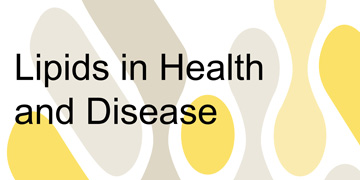
Similarly, in 2012, the same journal published another small study in which 13 patients with red and sore acne lesions took 930 mg of EPA for 12 weeks. The researchers counted the number of acne lesions on the patients’ skin before and after this course of treatment. The scientists found that taking omega-3 supplements improved acne 8 out of the 12 patients but actually worsened acne in 4 patients. In addition, 1 patient experienced no changes in acne. Taken together, these results are somewhat promising but mixed, suggesting that more research into omega-3 supplements as an acne treatment is sorely needed.4

The third, more rigorous study was published in the journal Acta Dermato-Venereologica in 2014. In this study, researchers divided 30 patients with mild-to-moderate acne into 2 equal groups. The first group received omega-3 fatty acids (1,000 mg of EPA and 1,000 mg of DHA) daily, while the second group received a placebo (inactive substance) daily for 10 weeks. This study did not include the ALA omega-3 fatty acid, which is usually not included in supplements. After 10 weeks, the patients who had been taking omega-3 fatty acids had significantly less acne than those who did not take omega-3 fatty acid supplements.3
These results are promising, and it makes sense that omega-3s can reduce acne since they reduce inflammation. However, the results need to be supported by follow-up studies before we can be certain that omega-3 fatty acids really do help with acne.
Conclusion
Evidence that omega-3 fatty acids can reduce acne is promising, but not yet established. A good recommendation for those who take omega-3 fatty acid supplements for acne is 2,000 mg of EPA and DHA combined per day. This equates to 6-7 fish oil pills or about 3 “concentrated” fish oil pills.
References
- Watanabe, Y. & Tatsuno, I. Omega-3 polyunsaturated fatty acids for cardiovascular diseases : present , past and future. Expert Rev. Clin. Pharmacol 0, (2017). https://www.ncbi.nlm.nih.gov/pubmed/28531360
- Molfino, A., Gioia, G., Fanelli, F. R. & Muscaritoli, M. The role for dietary omega-3 fatty acids supplementation in older adults. Nutrients 6, 4058 – 4072 (2014). https://www.ncbi.nlm.nih.gov/pubmed/25285409
- Jung, J. Y. et al. Effect of dietary supplementation with omega-3 fatty acid and gamma-linolenic acid on acne vulgaris: A randomised, double-blind, controlled trial. Acta Derm. Venereol 94, 521 – 526 (2014). https://www.ncbi.nlm.nih.gov/pubmed/24553997
- Khayef, G., Young, J., Burns-Whitmore, B. & Spalding, T. Effects of fish oil supplementation on inflammatory acne. Lipids Health Dis. 11, 165 (2012). https://pubmed.ncbi.nlm.nih.gov/23206895/
- Coderch, L., López, O., De La Maza, A. & Parra, J. L. Ceramides and skin function. Am. J. Clin. Dermatol. 4, 107 – 129 (2003). https://www.ncbi.nlm.nih.gov/pubmed/12553851
- National Institutes of Health. Omega-3 Fatty Acids – Health Professional Fact Sheet. https://ods.od.nih.gov/factsheets/Omega3FattyAcids-HealthProfessional/
- Siscovick, D. S. et al. Omega-3 Polyunsaturated Fatty Acid (Fish Oil) Supplementation and the Prevention of Clinical Cardiovascular Disease: A Science Advisory from the American Heart Association. Circulation 135, e867 – e884 (2017). https://www.ncbi.nlm.nih.gov/pubmed/28289069
- Chang, C. H., Tseng, P. T., Chen, N. Y., Lin, P. C., Lin, P. Y., Chang, J. P., Kuo, F. Y., Lin, J., Wu, M. C., Su, K. P. Safety and tolerability of prescription omega-3 fatty acids: A systematic review and meta-analysis of randomized controlled trials. Prostaglandins Leukot. Essent. Fatty Acids. 129, 1-12 (2018). https://www.ncbi.nlm.nih.gov/pubmed/29482765
- Siscovick, D. S. et al. Omega-3 Polyunsaturated Fatty Acid (Fish Oil) Supplementation and the Prevention of Clinical Cardiovascular Disease: A Science Advisory from the American Heart Association. Circulation 135, e867 – e884 (2017). https://www.ncbi.nlm.nih.gov/pubmed/28289069
- Rubin, M. G., Kim, K. & Logan, A. C. Acne vulgaris, mental health and omega-3 fatty acids: A report of cases. Lipids Health Dis. 7, 36 (2008). https://www.ncbi.nlm.nih.gov/pubmed/18851733
The post Is It Possible to Take Too Much Omega-3 Fatty Acids? appeared first on Acne.org.
